Interesting Objects -Some Information

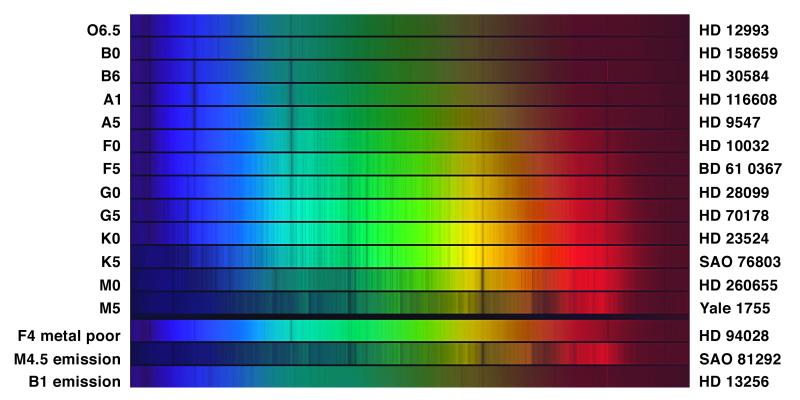
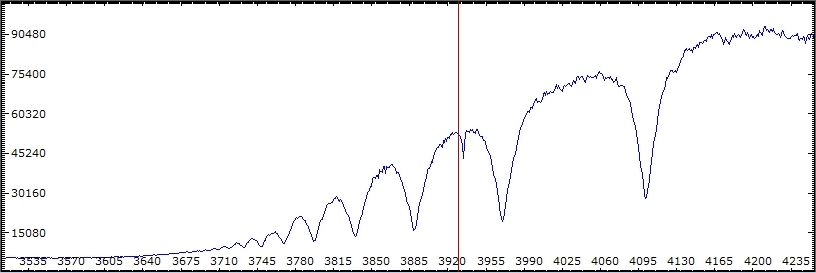
Interesting objects for observations
This section brings together some interesting and informative web links, documents and notes on some of the more interesting objects available to the amateur.
Francois' great webpage has some very good content (Be stars and novae) and links to the current and previous notes from Prof. Steve Shore. Well worth the read.
Wolf-Rayet Stars
These interesting emission stars are well worth observing. Since their discovery in 1867, there are now approx 227 catalogued. Many are found in the Cygnus area and the brightest is in the southern hemisphere - Gamma Vel, a WC8 type star..
WR VII Catalogue This is the latest and up-to-date WR catalogue.
The typical WR emission lines which can be recorded depends on the type of WR star (WC WO or WN), the typical spectra of WR stars (WC and WO types) can be found here and information on the WN type here.
The recent campaigns on WR 140 are documented here. Robin Leadbeater also has a nice HiRes WR140 on his website.
http://kookaburra.phyast.pitt.edu/hillier/publications/Wolf_Rayet_paper.pdf
Be Stars
The June 1975 issue of S&T contained a good overview of the emission Be stars by Su-Shu Huang.
There's a good overview of Shell Stars on this website, as well as some great links for further reading.
The BeSS database contains all the Be stars and is the repository of all the amateur (and professional) data.
There's a VO (Virtual Observatory) add-in available for the planetarium programs C2A and CdC which plot all the Be stars and identify the one's needing observation.
Deneb has been regularly observed and is a good target. See Noel Richardson's report here
Novae and SN
These transient phenomena present a great opportunity to contribute useful data to the community. Details of new discoveries are published in the Astronomer's Telegram and listed on the websites below.
Rochester Astronomy Provides details of all the latest SN discoveries
Super Nova Another listing of all SN
Novae This link provides practical information on the observing and recording of novae.
Nova Cygni is covered in the Nov75 Sky and telescope
Gelato SN A must have comparison site for any SN spectral images. Defines type 1 and type 2 SN.
SNID A SN Identification software by Stephane Blondin. Runs under Linux etc.
Paul Luckas recently observed the nova in Centarus
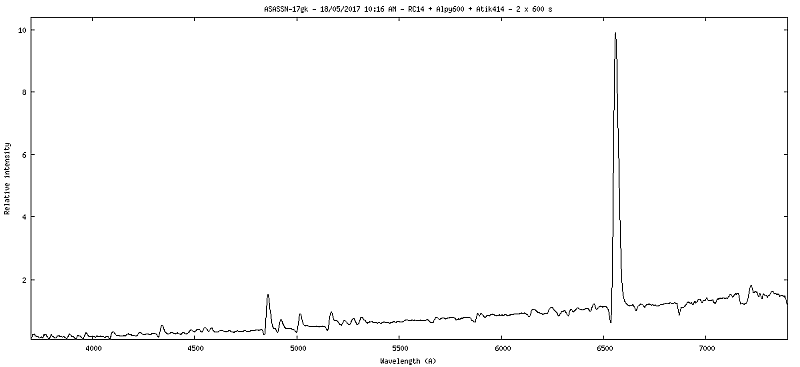
This clearly shows the hydrogen emission lines and the "Iron curtain" of Fe emissions around 5000A. Typical of a nova close to maximum.
Robin Leadbeater recorded SN2017eaw with a 200 l/mm modified ALPY and compared his data with GELATO
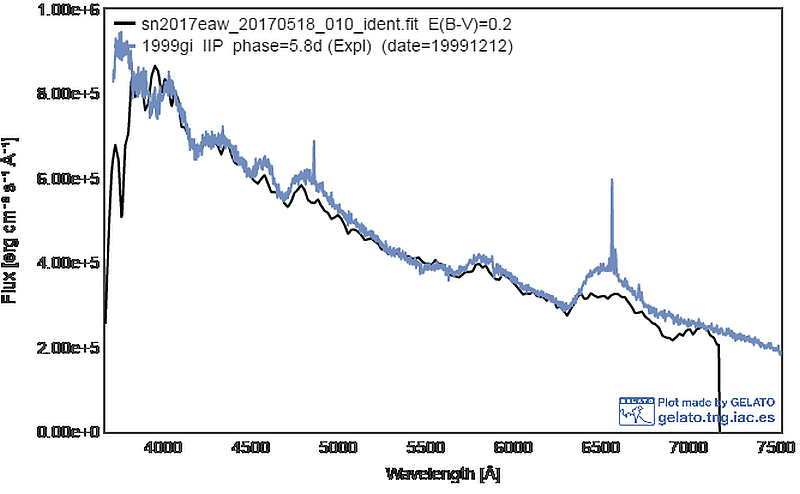
Variable Stars
Under construction
Meteors
Some interesting meteor spectra appear in the following issues of Sky and Telescope.
The BAA article 1991 Perseid meteor spectra is also informative.
The Millman document 115 years of meteor spectroscopy covers a lot of the historical ground.
Comets
The recent 2019/2020 comet NEOWISE was well observed by observers in the northern hemisphere. It also allowed many amateurs to obtain their first comet spectra. It was interesting to record the changes in the comet spectrum as it swung round the Sun.
The Swan bands (and Cyanogen (CN) are commonally recorded in comet spectra. The Na emission was also visible in NEOWISE.
annotated.jpg)
Christian Buil: UVEX spectrograph, annotated to show the prominent comet emission lines.
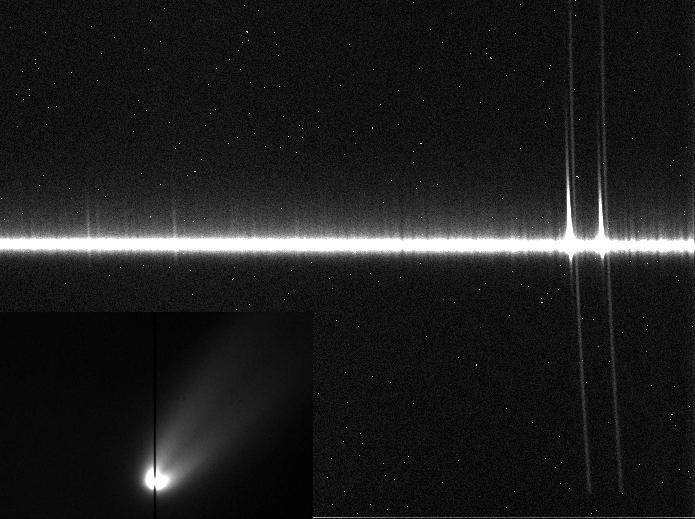
Robin Leadbeater: HiresIII spectrograph, Sodium (Na) emission, compared with stationary background street lamp emission. Note the wavelength change - the comet was moving towards us (blue Doppler shift).

Torsten Hansen: SA200 grating, 135mm telelens. Shows the reduction to the Na emission and the increased intensity of the Swan bands.
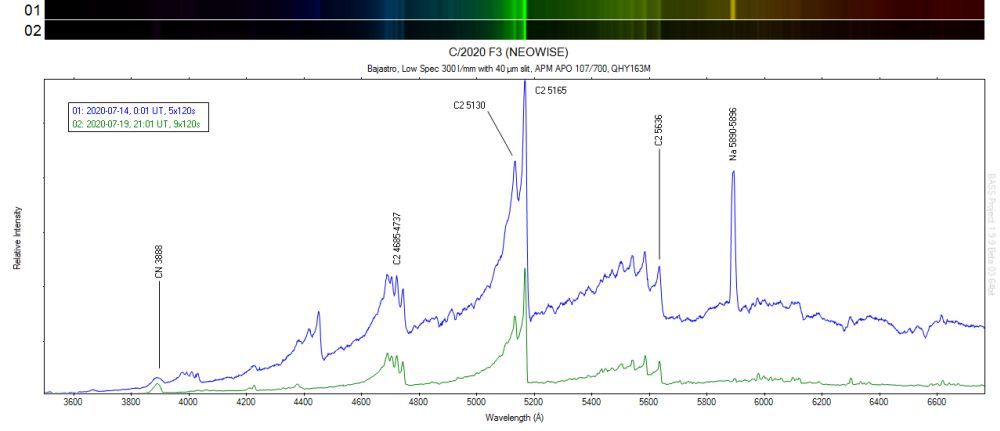
Bajastro: LowSpec spectrograph, annotated to show the prominent Swan band comet emission lines.
Quasars
Maurice Gavin (UK) was the first amateur to record the spectrum of a Quasar, 13th mag 3C273 in 1998. By using a Vega comparison spectrum he determined the redshift (z) as 0.16.
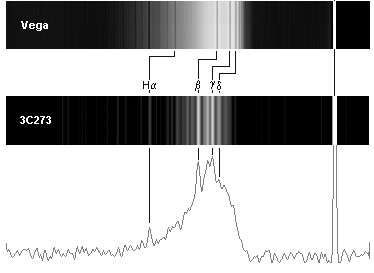
Planetary
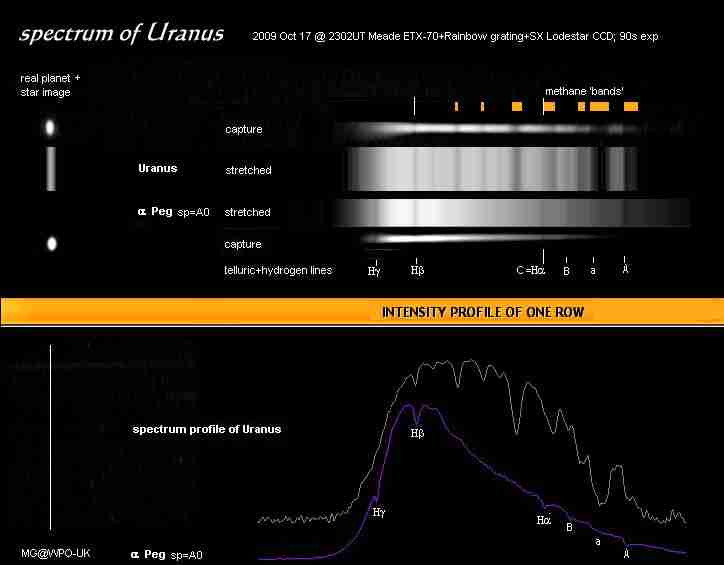
A spectrum of the moon or planets is a reflection spectrum of the Sun. If the spectrum is divided by a standard G2V spectrum, the planet's atmospheric make-up can be established. The Uranus spectrum above shows the method (Maurice Gavin)
If a slit spectrograph is used, we can measure the rotational speed of Jupiter or Saturn. By placing the slit across the planet's disk the red/ blue doppler shift can be recorded, as shown below.(Gingerich)

https://arxiv.org/pdf/1705.06323.pdf
Solar and Zeeman effect
Under construction
Nebulae
The emission lines of the brighter nebulae are usually dominated by hydrogen and oxygen. A slit spectrograph gives cleaner emission lines as shown below (A&A,94,12).

With a grating the shape of the nebula is shown in each emission line position.


The above image was taken using an SA100 grating mounted on a 55mm lens ( R Kaufmann).
Other Objects
Eta Car
They say there's only two things to be observed in the universe - Eta Carinae and the rest!
http://etacar2014.wdfiles.com/local-...etacar2014.pdf
http://etacar2014.wikidot.com/
http://spectro-aras.com/forum/viewtopic.php?f=2&t=645
http://iopscience.iop.org/article/10.1088/0004-6256/139/4/1534/pdf
http://iopscience.iop.org/article/10.3847/0004-637X/819/2/131/pdf
http://etacar2014.wikidot.com/
http://mnras.oxfordjournals.org/cont....full.pdf+html
Other Useful Information
ELODIE An on-line database of high-resolution stellar spectra.
Simbad A mandatory source for astronomical data. A must have link!
spectral library Comprehensive listing of useful catalogues.
Gray Spectral Atlas A Digital Spectral Classification Atlas. Comprehensive, definitive reference source.